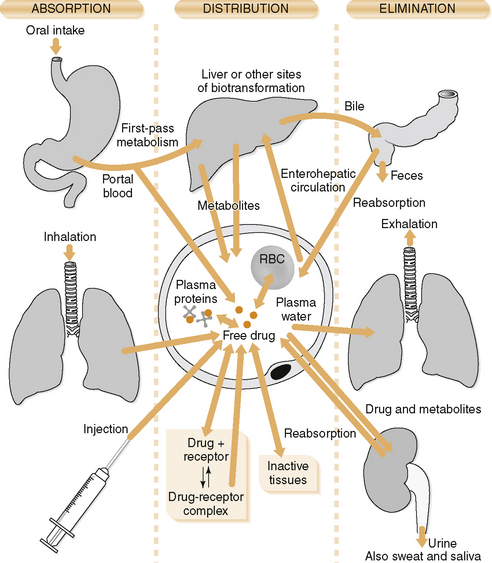What is the main function of the Na-K pump at the cellular level?
Move Na inside the cell
Move K out of the cell
Move Na out of the cell
Move Na and K inside the cell
The Correct Answer is C
Choice A: Move Na Inside the Cell
The primary function of the Na-K pump, also known as the sodium-potassium pump, is to move sodium (Na) ions out of the cell, not into the cell. This pump actively transports three sodium ions out of the cell for every two potassium ions it brings in. Therefore, this choice is incorrect.
Choice B: Move K Out of the Cell
The Na-K pump moves potassium (K) ions into the cell, not out of the cell. This active transport mechanism helps maintain the necessary concentration gradients of sodium and potassium across the cell membrane, which are crucial for various cellular functions, including maintaining the resting membrane potential.
Choice C: Move Na Out of the Cell
The main function of the Na-K pump is to move sodium ions out of the cell. For every cycle of the pump, three sodium ions are exported out of the cell, and two potassium ions are imported into the cell. This process is essential for maintaining the electrochemical gradient across the cell membrane, which is vital for nerve impulse transmission, muscle contraction, and overall cellular homeostasis.
Choice D: Move Na and K Inside the Cell
This choice is incorrect because the Na-K pump does not move both sodium and potassium ions inside the cell. Instead, it moves sodium ions out of the cell and potassium ions into the cell. This active transport mechanism is crucial for maintaining the proper ionic balance and membrane potential necessary for various physiological processes.
Nursing Test Bank
Naxlex Comprehensive Predictor Exams
Related Questions
Correct Answer is C
Explanation
Choice A Reason:
The sympathetic nervous system (SNS) plays a role in regulating body temperature. It does this by controlling the dilation and constriction of blood vessels in the skin, which helps to dissipate or conserve heat as needed. Therefore, the statement that the SNS regulates body temperature is correct.
Choice B Reason:
The SNS is crucial in regulating the cardiovascular system. It increases heart rate and the force of heart contractions, and it also causes vasoconstriction, which raises blood pressure. This statement is accurate and does not indicate a need for further teaching.
Choice C Reason:
This is the correct answer. The SNS generally inhibits digestive functions during the “fight-or-flight” response. It reduces blood flow to the digestive organs, decreases peristalsis, and inhibits digestive secretions. Therefore, the statement that the SNS regulates digestive functions is incorrect and indicates a need for further teaching.
Choice D Reason:
The SNS is responsible for the “fight-or-flight” response, which prepares the body to respond to perceived threats. This includes increasing heart rate, dilating airways, and mobilizing energy stores. This statement is correct and does not indicate a need for further teaching.
Correct Answer is D
Explanation
Choice A: Excretion
Excretion is the process by which drugs and their metabolites are eliminated from the body, primarily through the kidneys (urine), but also via bile, sweat, saliva, and other routes. While excretion is a crucial phase of pharmacokinetics, it is not directly impacted by the first pass effect. The first pass effect primarily involves the metabolism of a drug before it reaches systemic circulation, which occurs prior to the excretion phase.
Choice B: Metabolism
The first pass effect, also known as first-pass metabolism or presystemic metabolism, significantly impacts the metabolism phase of pharmacokinetics. This phenomenon occurs when a drug is metabolized at a specific location in the body, such as the liver or gut wall, before it reaches systemic circulation. As a result, the concentration of the active drug is reduced, affecting its bioavailability. The liver is the primary site for this metabolic process, where enzymes break down the drug, potentially leading to a significant reduction in its therapeutic effect.
Choice C: Distribution
Distribution refers to the process by which a drug is transported from the bloodstream to various tissues and organs in the body. This phase is influenced by factors such as blood flow, tissue permeability, and binding to plasma proteins. However, the first pass effect does not directly alter the distribution phase. Instead, it affects the amount of drug that enters systemic circulation, which in turn can influence the extent of distribution.
Choice D: Absorption
Absorption is the process by which a drug enters the bloodstream from its site of administration. This phase is crucial for determining the onset of a drug’s action. While the first pass effect occurs after absorption, it does not directly change the absorption phase itself. Instead, it affects the drug’s concentration after it has been absorbed and before it reaches systemic circulation.

Whether you are a student looking to ace your exams or a practicing nurse seeking to enhance your expertise , our nursing education contents will empower you with the confidence and competence to make a difference in the lives of patients and become a respected leader in the healthcare field.
Visit Naxlex, invest in your future and unlock endless possibilities with our unparalleled nursing education contents today
Report Wrong Answer on the Current Question
Do you disagree with the answer? If yes, what is your expected answer? Explain.
Kindly be descriptive with the issue you are facing.
